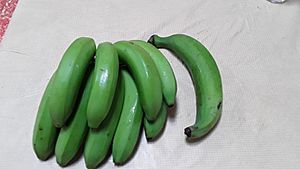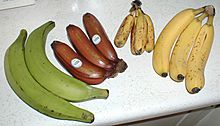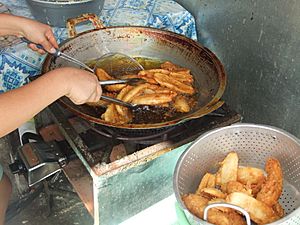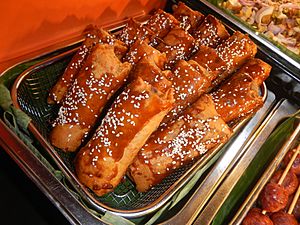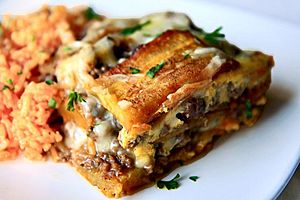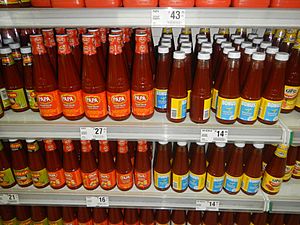Cooking banana facts for kids
Quick facts for kids Cooking bananas |
|
|---|---|

Large bunch of cooking bananas
|
|
| Genus | Musa |
| Species | Musa × paradisiaca |
| Hybrid parentage | M. acuminata × M. balbisiana |
| Cultivar group | Cultivars from a number of groups, including the AAA Group, the AAB Group and the ABB Group |
| Origin | primary: Southeast Asia; secondary: West Africa; tertiary: Central America |
Cooking bananas are types of banana plants whose fruits are usually cooked before eating. They can be eaten when they are ripe or unripe and are often full of starch. Many cooking bananas are called plantains or green bananas, even though not all of them are "true plantains." When cooked, bananas act like a starchy vegetable with a mild taste and soft texture. Bananas grow all year, making them a reliable food source.
Cooking bananas are a very important food in West and Central Africa, the Caribbean islands, Central America, and northern South America. Bananas originally came from the tropical parts of Southeast Asia and Oceania. Africa is also a major area where many different kinds of bananas grow. For example, some plantains are from West Africa, and East African Highland bananas (called matoke in Uganda) are from the central highlands. Most of these are cooked, but some are used to make beer.
The word "plantain" often refers to any banana that is usually cooked. However, there isn't a strict scientific difference between bananas and plantains. Cooking them is often just a tradition, not always a must. Ripe plantains can actually be eaten raw because their starches turn into sugars as they ripen. In some countries, people clearly separate "plantains" from "bananas." But in places where many kinds of bananas are eaten, there might not be a special name for each.
In science, the term "plantain" is only used for true plantains. Other starchy bananas used for cooking are simply called "cooking bananas." Most true plantains today have three sets of chromosomes, meaning they are triploid. Many are hybrids (mixtures) of two wild banana types: Musa acuminata and Musa balbisiana. The scientific name for all these mixed types is Musa × paradisiaca. Cooking bananas often belong to groups like the AAB Group, AAA Group (like the East African Highland bananas), or ABB Group (like Saba bananas).
Fe'i bananas from the Pacific Islands are often roasted or boiled. People sometimes call them "mountain plantains." However, they are not from the same two wild species that most modern bananas come from.
What Are Cooking Bananas Like?
Plantains have more starch and less sugar than sweet dessert bananas. This is why they are usually cooked or processed before you eat them. Green, unripe plantains are often boiled or fried. When processed, they can be made into flour for baking things like cakes, bread, and pancakes.
Green plantains can also be boiled and mashed to thicken soups. The inside of a green plantain is usually hard, and its peel is so tough you often need a knife to remove it.
When plantains are ripe and yellow, you can peel them like regular bananas. The inside is softer than green fruit, and some of the starch has turned into sugar. You can eat them raw, but they are not as tasty as dessert bananas, so they are usually cooked. When yellow plantains are fried, they often turn golden-brown and become a bit sweet. You can also boil, bake, microwave, or grill them, either peeled or unpeeled.
Plantains are a very important staple food in tropical areas around the world. They are ranked as the tenth most important staple food globally. As a staple, plantains are used much like potatoes. They have a similar mild flavor and texture when the unripe fruit is cooked by steaming, boiling, or frying.
Since plantains grow all year, they are a reliable food source, especially in developing countries where it's hard to store or transport food. In Africa, plantains and bananas provide over a quarter of the daily calories for more than 70 million people. However, banana farms can be easily destroyed by hurricanes because banana plants don't handle strong winds well.
An average plantain gives you about 220 calories and is a good source of potassium and fiber. The sticky juice from the fruit peel and the whole plant can stain clothes and hands, and it's hard to wash off.
Banana Family Tree
Linnaeus, a famous scientist, first sorted bananas into two types based on how they were used: Musa paradisiaca for plantains and Musa sapientum for sweet dessert bananas. We now know that both are hybrids (mixtures) of two wild species: Musa acuminata and Musa balbisiana.
The name Musa × paradisiaca is now used for all these mixed types. Most modern plantains cannot reproduce on their own and have three sets of chromosomes (they are triploid). They belong to the AAB Group, sometimes called the "Plantain group." Other important cooking banana groups include the East African Highland bananas (from the AAA Group) and Pacific plantains (also from the AAB Group).
Tasty Plantain Dishes
Many countries around the world use cooking bananas in their traditional foods. Here are some examples:
Africa
- In the Ivory Coast, a dish called aloco uses fried plantains as the main part. It's often served with an onion-tomato sauce and grilled fish.
- Boli or Bole is roasted plantain in Nigeria. It's usually grilled and served with roasted fish, peanuts, and a spicy palm oil sauce. It's a popular lunch snack in southern and western Nigeria.
- In West Africa (like Cameroon, Ghana, and Nigeria), ripe fried plantain is called dodo. The plantain is sliced diagonally and fried until golden brown. It can be eaten alone or with a stew.
- In Ikire, Nigeria, Dodo ikire is a special fried plantain dish. It's made from very ripe plantain, chopped small, spiced with chili pepper, and fried until dark. Then it's pressed into a cone shape.
- Matooke or matoke is a cooking banana dish from Uganda. The bananas are peeled, wrapped in banana leaves, and steamed for a few hours. When cooked, they become soft and yellow. The matoke is then mashed and served with a sauce made from vegetables, peanuts, or meat.
Caribbean
- Fufu de platano is a popular dish in Cuba. It's made by boiling plantains and mashing them. Then it's mixed with chicken broth and sofrito, a sauce with garlic, onions, and tomato.
- Eto is a traditional Ghanaian dish made from boiled and mashed yam or plantain. The plantain version, called 'Boodie eto', can use unripe, slightly ripe, or fully ripe plantains.
- In the Dominican Republic, mangú is made from boiled green plantains mashed with hot water. It's often eaten for breakfast with fried red onions, fried eggs, fried cheese, or fried Dominican salami.
Central and South America
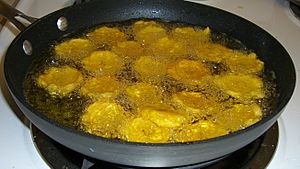
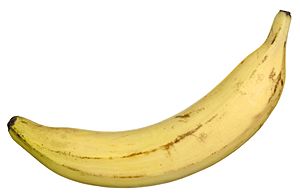
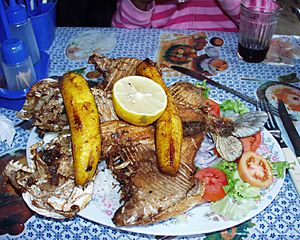
- Cayeye, also called Mote de Guineo, is a traditional Colombian dish. Green bananas or plantains are cooked, mashed, and mixed with a refrito (sautéed onions, garlic, and tomato). It's usually served for breakfast with cheese, fried fish, or a fried egg.
- Chifles are thinly sliced fried green plantains in Peru and Ecuador. In Ecuador, boiled, mashed, and fried plantain is called majado. It's a popular breakfast dish, often served with coffee and meat or cheese.
- In Honduras, Venezuela, and Central Colombia, fried ripe plantain slices are called tajadas. They are a common side dish with most meals. Some versions add honey or sugar and are fried in butter for a sweeter taste.
- In Panama, tajadas are eaten daily with steamed rice, meat, and beans.
- In Nicaragua, tajadas are fried unripe plantain slices. They are traditionally served with fried pork or on their own with cabbage salad or fresh cheese.
- Tostones (also known as patacones in many countries) are plantain patties fried twice. Plantains are sliced, fried, smashed flat, and then fried again. They are often seasoned with salt. In some places, they are dipped in a sauce before eating.
India
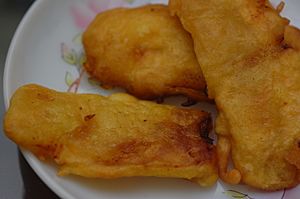
- Ethakka appam or pazham pori are names for fried plantain in Kerala. The plantain is dipped in a sweet batter and fried in coconut or vegetable oil. It's a very popular snack.
- Another way to cook plantains in Kerala is to boil or steam them. Sometimes they are filled with grated coconut, spices, and sugar, then cooked in butter.
Indonesia
- Nagasari is a traditional steamed cake made from rice flour, coconut milk, and sugar, with banana slices inside. It's usually wrapped in banana leaves and steamed.
- Pisang goreng ("fried banana") is a popular snack in Indonesia, Malaysia, Singapore, and Brunei. Plantains are deep-fried in coconut oil, sometimes coated in batter.
Philippines
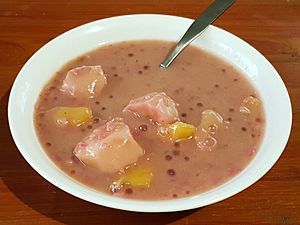
The most important cooking banana in the Philippines is the saba banana. These are smaller than Latin American varieties. Saba bananas are often cooked when ripe for dessert dishes:
- Banana cue - fried ripe saba bananas covered in caramelized sugar.
- Binignit - a sweet soup with glutinous rice, coconut milk, and ripe saba bananas.
- Turon - a dessert made from ripe saba bananas wrapped in a thin pastry and fried, like a spring roll.
Savory dishes using saba bananas include:
- Arroz a la Cubana - a rice dish served with a side of fried bananas.
- Nilagang saging - boiled saba bananas, often eaten with a fermented shrimp paste or vinegar.
Puerto Rico
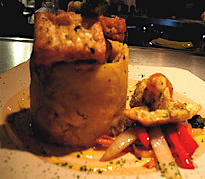
Puerto Rico has many dishes that use plantains.
- Alcapurria is a savory fried pastry. It's usually made from grated green bananas and other root vegetables, filled with ground meat.
- Mofongo is made by mashing fried plantains in a mortar with pork cracklings or bacon, garlic, olive oil, and broth. It's shaped into balls and eaten warm, often with chicken broth.
- Pasteles are a type of dumpling made from green banana, green plantains, and other tubers. They are filled with stewed pork and wrapped in banana leaves, usually served at Christmas.
- Pastelon is like lasagna, but it uses sweet plantains instead of pasta layers.
Other Ways to Prepare Plantains
Chips
After peeling, unripe plantains can be sliced thinly and deep fried in hot oil to make chips. These thin chips are known by different names like tostones, patacones, or chifles in various countries. In Cuba, thin plantain chips are called mariquitas.
In South India (Kerala), chips fried in coconut oil and salted are called upperi or kaya varuthathu. They are an important snack during festivals. These chips are usually labeled "plantain chips" because they taste starchy, like potato chips.
Dried Flour
Plantains are also dried and ground into flour, which is called "banana meal." This is an important food. In southern India, dried plantain powder is mixed with fennel seed powder and boiled in milk or water to make baby food.
Drinks
In Peru, plantains are boiled and blended with water, spices, and sugar to make a drink called chapo. In Kerala, ripe plantains are boiled with sago, coconut milk, sugar, and spices to make a pudding.
Ketchup
The Philippines makes a special banana ketchup from saba bananas. It was first created during World War II as a replacement for tomato ketchup.
Plantain Nutrition
| Nutritional value per 100 g (3.5 oz) | |
|---|---|
| Energy | 510 kJ (120 kcal) |
|
31.89 g
|
|
| Sugars | 10 g |
| Dietary fiber | 2.3 g |
|
0.37 g
|
|
|
Protein
|
1.3 g
|
| Vitamins | Quantity
%DV†
|
| Vitamin A equiv.
beta-Carotene
|
7%
56 μg
4%
457 μg |
| Thiamine (B1) |
5%
0.052 mg |
| Riboflavin (B2) |
5%
0.054 mg |
| Niacin (B3) |
4%
0.686 mg |
| Pantothenic acid (B5) |
5%
0.26 mg |
| Vitamin B6 |
23%
0.299 mg |
| Folate (B9) |
6%
22 μg |
| Choline |
3%
13.5 mg |
| Vitamin C |
22%
18.4 mg |
| Vitamin E |
1%
0.14 mg |
| Vitamin K |
1%
0.7 μg |
| Minerals | Quantity
%DV†
|
| Calcium |
0%
3 mg |
| Iron |
5%
0.6 mg |
| Magnesium |
10%
37 mg |
| Phosphorus |
5%
34 mg |
| Potassium |
17%
499 mg |
| Sodium |
0%
4 mg |
| Zinc |
1%
0.14 mg |
| Other constituents | Quantity |
| Water | 65.3 g |
|
Full Link to USDA Database entry
|
|
| †Percentages estimated using US recommendations for adults. | |
Plantains are mostly carbohydrates (about 32%), with some dietary fiber (2%) and sugars (15%). They also have a little protein (1%) and fat (0.4%), and are mostly water (65%). A 100-gram serving gives you about 122 calories. Raw plantains are a great source of vitamin B6 and vitamin C. They also provide a good amount of magnesium and potassium.
Plantains don't have much beta-carotene, so they are not a good source of vitamin A.
How Plantains Compare to Other Foods
The table below shows how plantains compare in nutrients to other main staple foods. This comparison is based on their dry weight, which helps account for different water contents.
| Staple | Maize (corn)[A] | Rice, white[B] | Wheat[C] | Potatoes[D] | Cassava[E] | Soybeans, green[F] | Sweet potatoes[G] | Yams[Y] | Sorghum[H] | Plantain[Z] | RDA |
|---|---|---|---|---|---|---|---|---|---|---|---|
| Water content (%) | 10 | 12 | 13 | 79 | 60 | 68 | 77 | 70 | 9 | 65 | |
| Raw grams per 100g dry weight | 111 | 114 | 115 | 476 | 250 | 313 | 435 | 333 | 110 | 286 | |
| Nutrient | |||||||||||
| Energy (kJ) | 1698 | 1736 | 1574 | 1533 | 1675 | 1922 | 1565 | 1647 | 1559 | 1460 | 8,368–10,460 |
| Protein (g) | 10.4 | 8.1 | 14.5 | 9.5 | 3.5 | 40.6 | 7.0 | 5.0 | 12.4 | 3.7 | 50 |
| Fat (g) | 5.3 | 0.8 | 1.8 | 0.4 | 0.7 | 21.6 | 0.2 | 0.6 | 3.6 | 1.1 | 44–77 |
| Carbohydrates (g) | 82 | 91 | 82 | 81 | 95 | 34 | 87 | 93 | 82 | 91 | 130 |
| Fiber (g) | 8.1 | 1.5 | 14.0 | 10.5 | 4.5 | 13.1 | 13.0 | 13.7 | 6.9 | 6.6 | 30 |
| Sugar (g) | 0.7 | 0.1 | 0.5 | 3.7 | 4.3 | 0.0 | 18.2 | 1.7 | 0.0 | 42.9 | minimal |
| Minerals | [A] | [B] | [C] | [D] | [E] | [F] | [G] | [Y] | [H] | [Z] | RDA |
| Calcium (mg) | 8 | 32 | 33 | 57 | 40 | 616 | 130 | 57 | 31 | 9 | 1,000 |
| Iron (mg) | 3.01 | 0.91 | 3.67 | 3.71 | 0.68 | 11.09 | 2.65 | 1.80 | 4.84 | 1.71 | 8 |
| Magnesium (mg) | 141 | 28 | 145 | 110 | 53 | 203 | 109 | 70 | 0 | 106 | 400 |
| Phosphorus (mg) | 233 | 131 | 331 | 271 | 68 | 606 | 204 | 183 | 315 | 97 | 700 |
| Potassium (mg) | 319 | 131 | 417 | 2005 | 678 | 1938 | 1465 | 2720 | 385 | 1426 | 4700 |
| Sodium (mg) | 39 | 6 | 2 | 29 | 35 | 47 | 239 | 30 | 7 | 11 | 1,500 |
| Zinc (mg) | 2.46 | 1.24 | 3.05 | 1.38 | 0.85 | 3.09 | 1.30 | 0.80 | 0.00 | 0.40 | 11 |
| Copper (mg) | 0.34 | 0.25 | 0.49 | 0.52 | 0.25 | 0.41 | 0.65 | 0.60 | - | 0.23 | 0.9 |
| Manganese (mg) | 0.54 | 1.24 | 4.59 | 0.71 | 0.95 | 1.72 | 1.13 | 1.33 | - | - | 2.3 |
| Selenium (μg) | 17.2 | 17.2 | 81.3 | 1.4 | 1.8 | 4.7 | 2.6 | 2.3 | 0.0 | 4.3 | 55 |
| Vitamins | [A] | [B] | [C] | [D] | [E] | [F] | [G] | [Y] | [H] | [Z] | RDA |
| Vitamin C (mg) | 0.0 | 0.0 | 0.0 | 93.8 | 51.5 | 90.6 | 10.4 | 57.0 | 0.0 | 52.6 | 90 |
| Thiamin (B1) (mg) | 0.43 | 0.08 | 0.34 | 0.38 | 0.23 | 1.38 | 0.35 | 0.37 | 0.26 | 0.14 | 1.2 |
| Riboflavin (B2) (mg) | 0.22 | 0.06 | 0.14 | 0.14 | 0.13 | 0.56 | 0.26 | 0.10 | 0.15 | 0.14 | 1.3 |
| Niacin (B3) (mg) | 4.03 | 1.82 | 6.28 | 5.00 | 2.13 | 5.16 | 2.43 | 1.83 | 3.22 | 1.97 | 16 |
| Pantothenic acid (B5) (mg) | 0.47 | 1.15 | 1.09 | 1.43 | 0.28 | 0.47 | 3.48 | 1.03 | - | 0.74 | 5 |
| Vitamin B6 (mg) | 0.69 | 0.18 | 0.34 | 1.43 | 0.23 | 0.22 | 0.91 | 0.97 | - | 0.86 | 1.3 |
| Folate Total (B9) (μg) | 21 | 9 | 44 | 76 | 68 | 516 | 48 | 77 | 0 | 63 | 400 |
| Vitamin A (IU) | 238 | 0 | 10 | 10 | 33 | 563 | 4178 | 460 | 0 | 3220 | 5000 |
| Vitamin E, alpha-tocopherol (mg) | 0.54 | 0.13 | 1.16 | 0.05 | 0.48 | 0.00 | 1.13 | 1.30 | 0.00 | 0.40 | 15 |
| Vitamin K1 (μg) | 0.3 | 0.1 | 2.2 | 9.0 | 4.8 | 0.0 | 7.8 | 8.7 | 0.0 | 2.0 | 120 |
| Beta-carotene (μg) | 108 | 0 | 6 | 5 | 20 | 0 | 36996 | 277 | 0 | 1306 | 10500 |
| Lutein+zeaxanthin (μg) | 1506 | 0 | 253 | 38 | 0 | 0 | 0 | 0 | 0 | 86 | 6000 |
| Fats | [A] | [B] | [C] | [D] | [E] | [F] | [G] | [Y] | [H] | [Z] | RDA |
| Saturated fatty acids (g) | 0.74 | 0.20 | 0.30 | 0.14 | 0.18 | 2.47 | 0.09 | 0.13 | 0.51 | 0.40 | minimal |
| Monounsaturated fatty acids (g) | 1.39 | 0.24 | 0.23 | 0.00 | 0.20 | 4.00 | 0.00 | 0.03 | 1.09 | 0.09 | 22–55 |
| Polyunsaturated fatty acids (g) | 2.40 | 0.20 | 0.72 | 0.19 | 0.13 | 10.00 | 0.04 | 0.27 | 1.51 | 0.20 | 13–19 |
| [A] | [B] | [C] | [D] | [E] | [F] | [G] | [Y] | [H] | [Z] | RDA |
A raw yellow dent corn
B raw unenriched long-grain white rice
C raw hard red winter wheat
D raw potato with flesh and skin
E raw cassava
F raw green soybeans
G raw sweet potato
H raw sorghum
Y raw yam
Z raw plantains
/* unofficial
Allergies to Plantains
Some people can have allergies to plantains and bananas. This can cause symptoms like itching or mild swelling of the lips, tongue, or throat. It might also cause a skin rash, stomach problems, or in rare cases, a serious reaction called anaphylactic shock. Scientists have found many proteins in bananas that can cause allergies.
|
See also
 In Spanish: Plátano verde para niños
In Spanish: Plátano verde para niños


